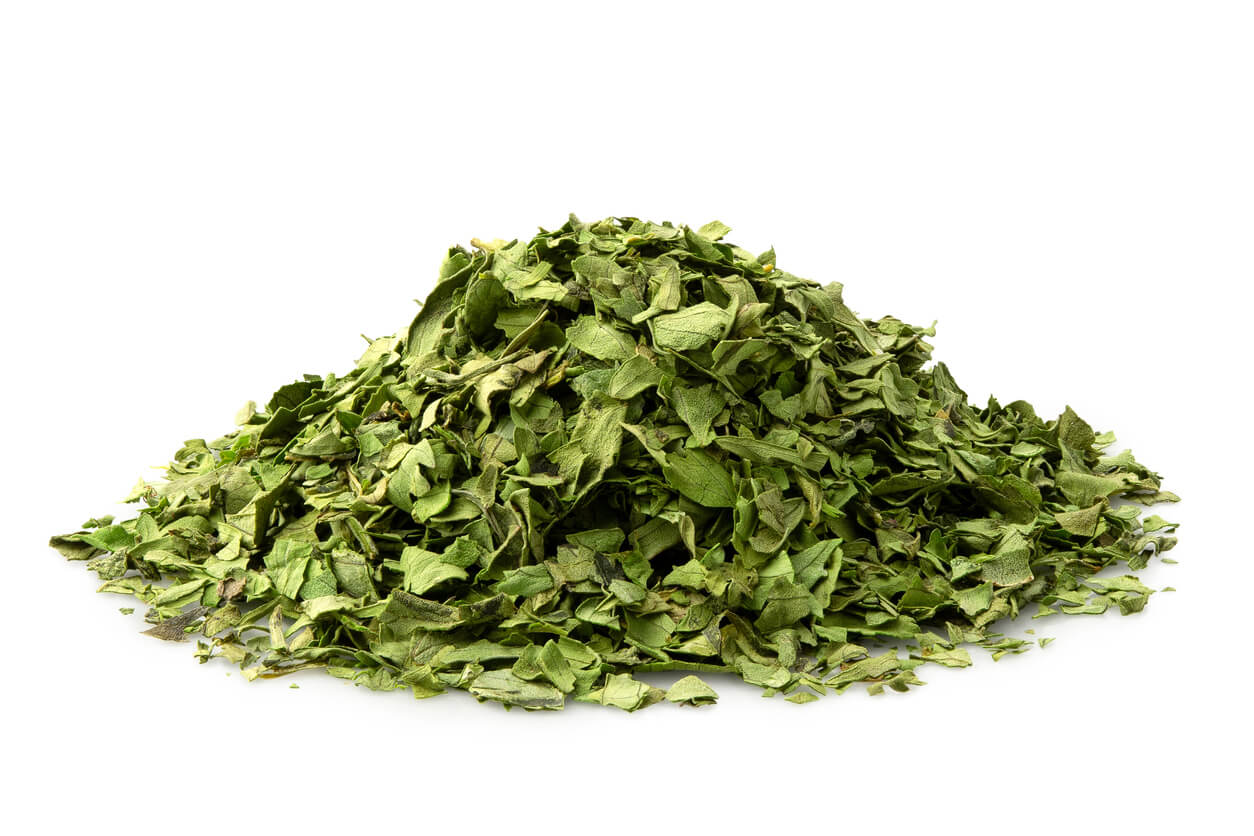
Dried cilantro leaves
After you’ve spent time and energy nurturing your cilantro plants into leafy deliciousness, you want those tasty leaves to last a while so you can us them in your favorite recipes. How many times have you had cilantro or its cousin parsley come home from the market all fresh and bright, only to see it wilt and fade faster than you can use it? Yeah, we’ve all been there.
Refrigerating, freezing, and drying are your three best options for storing and preserving cilantro. Now, some people will say freezing robs cilantro of essential enzymes; others will say drying it will make it last longer but also make it less flavorful. How you choose to preserve your cilantro depends on what you plan to do with it and your preference for storing it. Maybe you’ll try a little of each method!
Refrigerating Your Cilantro
The best way to keep your cilantro fresh and ready to use is to store it unwashed. Wrap your cilantro in a paper towel and put it in a plastic produce bag. The cilantro will stay fresh for about a week.
Another way to keep your cilantro fresh in the fridge is to wash a bunch of cilantro, dry it, then put it stem-down into a mason jar with a couple inches of water in it. Cover the picked cilantro loosely with a plastic bag and use within a week.
If you have a lot of cilantro and you’d like to keep it on hand for more than a week, there’s another refrigerating method you can try. Wash and dry your cilantro, then lay it out on a double layer of paper towels. Fold the sides over to keep your cilantro wrapped. Put this little bundle into an airtight container and put it in the fridge. It should last up to three weeks. After about a week, change out the paper towel, and toss out any leaves that have started to brown.
If your cilantro is looking a little tired when you take it out of the fridge to use it, just pop it into a bowl of cold water for a couple minutes. Dry it off and it should be ready for your next recipe!
Freezing Your Cilantro
Freezing your cilantro will give you a ready supply that will be good for about six months. Frozen cilantro will lose its texture and some of its color, but it will retain most of its flavor. Plan to use it in soups and sauces (soggy thawed leaves don’t really work well in salsa).
Wash you cilantro and use a salad spinner to remove most of the excess water. Pick the leaves off the stems and lay the leaves in a single layer on paper towel. When the leaves are dry, spread them on a baking sheet lined with waxed paper and pop the baking sheet in the freezer for about an hour. Portion out your cilantro leaves into labeled freezer bags. When it comes time to use your frozen cilantro, don’t thaw it; just add it to your recipe.
Another freezing method calls for putting clean, chopped cilantro—leaves and all—into ice cube trays. Top with water or olive oil, freeze solid, and store in a labeled freezer bag for up to a month.
Dehydrating Your Cilantro
It’s a great feeling to reach for your spice rack and pull out a jar of something you grew yourself. It’s easy to dehydrate cilantro—you don’t even need a dehydrator! You can dry your cilantro in the oven or even in the microwave.
Oven method:
- Preheat your oven to 250 degrees F.
- Wash and dry your cilantro, separating the leaves and stems (save the stems to flavor soups and sauces).
- Spread dry leaves in a single layer on a parchment-lined baking sheet (a rimless one is best).
- Bake for 30 minutes, or until the leaves are dry and crumbly.
- Remove from the oven and let the leaves cool completely. Store them in an airtight container. Dried cilantro leaves can last about a year, sometimes more.
Microwave method:
- Wash your cilantro and dry it (a salad spinner is especially helpful here). Make sure the leaves are completely dry before you begin dehydrating.
- Cover a microwave-safe plate with a paper towel.
- Spread the dry leaves in a single layer.
- Microwave for one minute on high. Check to see if the leaves are completely dry and crunchy. Microwave in 10-second increments until leaves are sufficiently dry.
- Strip the dried leaves off the stems. Crush the leaves and store them in an airtight container for up to a year.
A note about drying
To make sure your cilantro is well and truly dried, you should consider conditioning it. The process is simple: once you put your dried cilantro into a jar, shake the jar once a day for a week. Look for any signs of moisture. If you do find moisture, you can dry the leaves a little more. But if you spot mold, toss out the whole batch.
How often do you harvest your cilantro? Do you preserve just the leaves? The leaves and stems? The seeds? What’s your favorite preservation method? Please share your cilantro/coriander preservation tips!


 Previous
Previous

